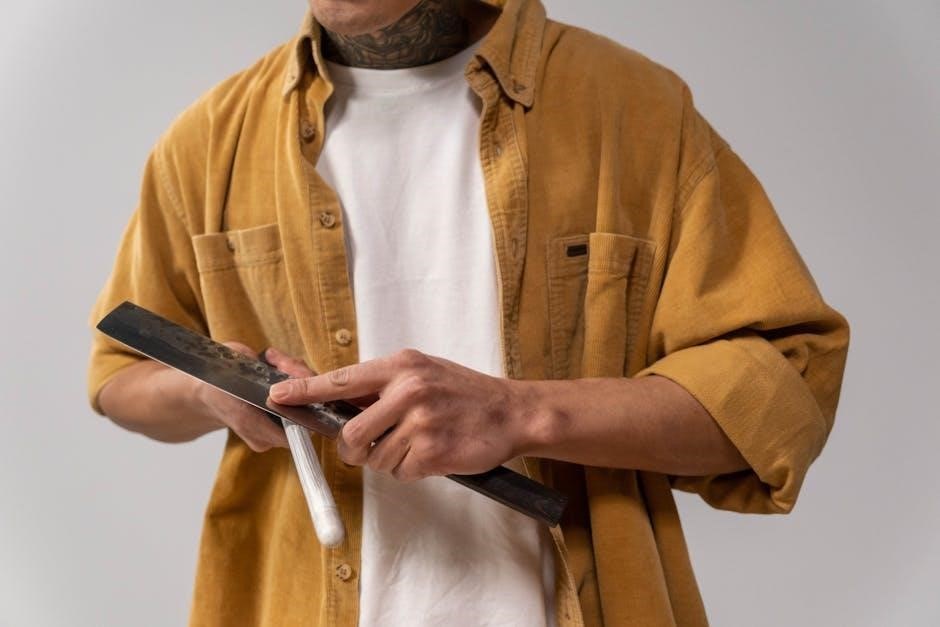This guide provides information on knife sharpening methods and techniques‚ including selecting tools and maintenance‚ with a focus on achieving razor-sharp edges and proper knife care using various sharpening tools and methods available online today.
Importance of Knife Sharpening
Knife sharpening is a crucial aspect of knife maintenance‚ as a dull knife can be dangerous and difficult to use. A sharp knife‚ on the other hand‚ is safer and more efficient‚ making it an essential tool for various tasks. The importance of knife sharpening lies in its ability to improve the overall performance of the knife‚ extending its lifespan and reducing the risk of accidents. By sharpening a knife‚ individuals can ensure that it remains in good condition‚ cutting effectively and effortlessly. Furthermore‚ regular sharpening can help prevent the knife from becoming dull and rusty‚ which can lead to a decrease in its overall quality. With the right sharpening techniques and tools‚ individuals can maintain their knives and ensure they remain sharp and functional‚ making them a valuable asset in various settings‚ including kitchens‚ workshops‚ and outdoor environments‚ where a sharp knife is essential for safety and productivity. Proper knife sharpening is essential for achieving optimal results and prolonging the life of the knife.
Overview of Knife Sharpening Techniques
Knife sharpening techniques vary depending on the type of knife and the desired level of sharpness. There are several methods to sharpen a knife‚ including using a whetstone‚ honing rod‚ or electric sharpener. Each technique requires a specific set of skills and knowledge to achieve optimal results. The process of sharpening a knife involves removing small amounts of metal from the blade to create a sharp edge. This can be done using various tools and materials‚ such as water stones‚ oil stones‚ or diamond stones. The choice of technique and tool depends on the individual’s preference and the type of knife being sharpened. Some techniques‚ such as freehand sharpening‚ require a great deal of skill and practice to master‚ while others‚ such as using a sharpening guide‚ can be easier to learn and use. Overall‚ the key to successful knife sharpening is to understand the different techniques and tools available and to practice regularly to develop the necessary skills. By doing so‚ individuals can achieve a sharp and functional knife that meets their needs and preferences. Various online resources provide detailed instructions and tutorials on knife sharpening techniques.

Understanding Knife Sharpening Angles

Sharpening angles are crucial for effective knife sharpening‚ requiring precise measurements and calculations for optimal results always using correct techniques and tools available online today easily.
Factors Affecting Sharpening Angles
Several factors affect sharpening angles‚ including the type of knife‚ its intended use‚ and the material of the blade. The angle at which a knife is sharpened can significantly impact its performance and durability. For instance‚ a knife used for cutting soft materials may require a smaller angle‚ while a knife used for cutting hard materials may require a larger angle. The thickness of the blade is also an important consideration‚ as thicker blades may require larger angles to achieve optimal sharpness. Additionally‚ the type of sharpening tool used can also impact the sharpening angle‚ with some tools allowing for more precise control over the angle than others. Understanding these factors is crucial for achieving the optimal sharpening angle and ensuring the knife performs as intended. By considering these factors‚ individuals can adjust their sharpening technique to achieve the best possible results and extend the life of their knife.
Measuring and Calculating Sharpening Angles
To measure and calculate sharpening angles‚ several tools can be used‚ including an Angle Cube or a caliper. The Angle Cube is a simple and accurate tool that allows users to measure the angle of the knife edge. Alternatively‚ a caliper can be used to measure the thickness of the blade and calculate the optimal sharpening angle. An Angle Calculator can also be used to determine the correct angle based on the type of knife and its intended use. By using these tools‚ individuals can ensure that their knife is sharpened at the optimal angle‚ which is typically between 15-20 degrees for kitchen knives. Most kitchen and Chef knives have an incline of 2 degrees per side‚ while very thin and Japanese knives have an incline of 1 degree per side. Accurate measurement and calculation of sharpening angles are crucial for achieving optimal sharpness and performance.

Types of Knife Sharpening Tools
Various tools are available‚ including traditional and non-traditional options‚ such as whetstones and honing rods‚ for sharpening knives effectively and efficiently every time with proper technique and maintenance always required online.
Traditional Sharpening Tools
Traditional sharpening tools have been used for centuries to sharpen knives and other cutting instruments. These tools include whetstones‚ honing rods‚ and sharpening steels. Whetstones are made from natural or synthetic materials and are available in different grits‚ allowing for a range of sharpening and polishing options. Honing rods are long‚ thin rods made from steel or ceramic materials‚ used to realign and refine the edge of a knife. Sharpening steels are used to maintain and hone the edge of a knife‚ and are often used in conjunction with other sharpening tools. These traditional tools are still widely used today‚ and are often preferred by professionals and enthusiasts due to their effectiveness and versatility. They require a certain level of skill and technique to use effectively‚ but can produce exceptional results when used properly. With practice and patience‚ traditional sharpening tools can be used to achieve a razor-sharp edge on any knife. Traditional sharpening tools are also relatively inexpensive and can be found at most hardware stores or online retailers.
Non-Traditional Sharpening Tools
Non-traditional sharpening tools are unconventional items used to sharpen knives‚ often in a pinch or when traditional tools are not available. These tools can include everyday objects such as mousepads‚ sandpaper‚ and even coffee mugs. A mousepad‚ for example‚ can be used as a makeshift sharpening stone‚ with the rubber surface providing a unique sharpening experience. Sandpaper can also be used to sharpen a knife‚ particularly for scraping and refining the edge. A coffee mug‚ believe it or not‚ can be used as a sharpening stone‚ with the ceramic surface providing a coarse grit for sharpening. These non-traditional tools are not always the most effective‚ but they can be useful in emergency situations or when traveling. They often require more effort and technique than traditional tools‚ but can produce decent results with practice. Non-traditional sharpening tools are a testament to the resourcefulness of knife enthusiasts and can be a fun and creative way to sharpen a knife. They may not replace traditional tools‚ but they can be a useful addition to any knife sharpening kit. With a little creativity‚ anything can become a sharpening tool.

Precision Sharpening Guides and Techniques
Precision sharpening guides provide fast and easy results with interchangeable guides for precise cutting angles and consistent sharpening techniques available online for knife enthusiasts to achieve razor-sharp edges quickly.
Using Interchangeable Sharpening Guides
Interchangeable sharpening guides are a valuable tool for achieving precise cutting angles and consistent sharpening techniques. These guides can be easily swapped out to accommodate different knife types and sharpening needs. By using interchangeable sharpening guides‚ users can ensure that their knives are sharpened to the optimal angle‚ resulting in a razor-sharp edge. This is particularly useful for those who own multiple knives or need to sharpen knives with varying blade types. The guides are typically easy to install and remove‚ making it simple to switch between different sharpening angles and techniques. With interchangeable sharpening guides‚ users can experiment with different sharpening methods and find the one that works best for them. This versatility and precision make interchangeable sharpening guides an essential component of any knife sharpening system‚ allowing users to achieve professional-level results at home. Overall‚ interchangeable sharpening guides offer a convenient and effective way to sharpen knives with precision and accuracy.
